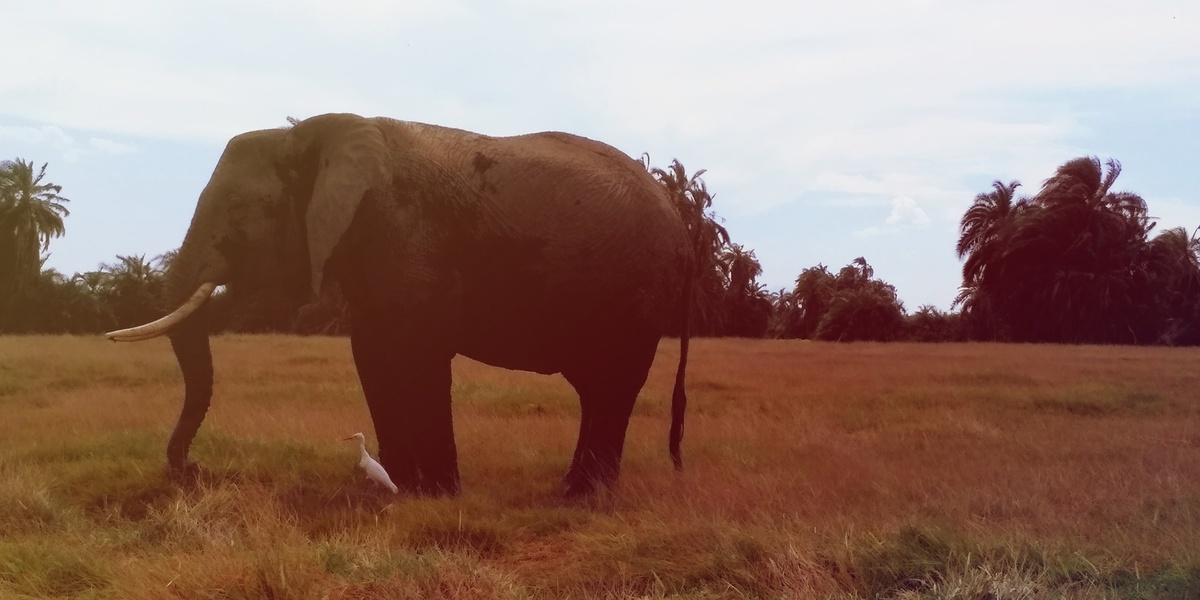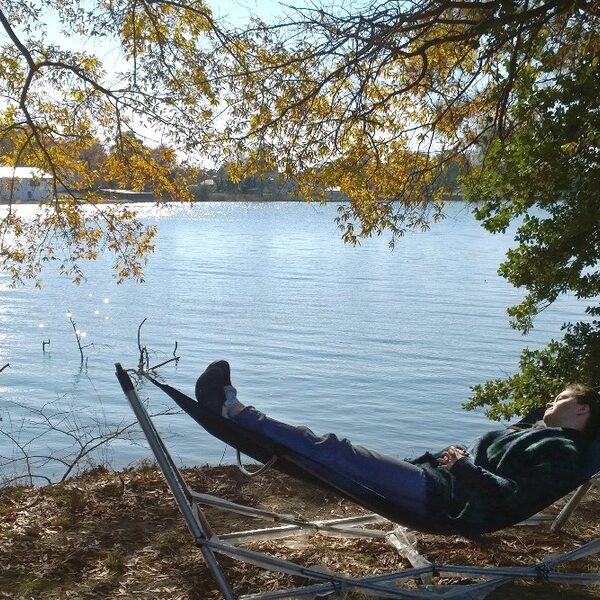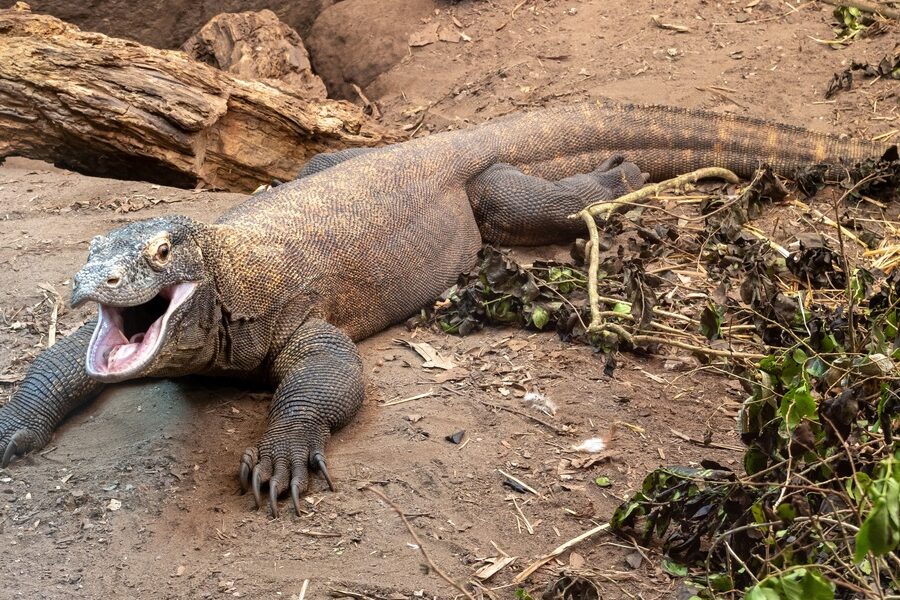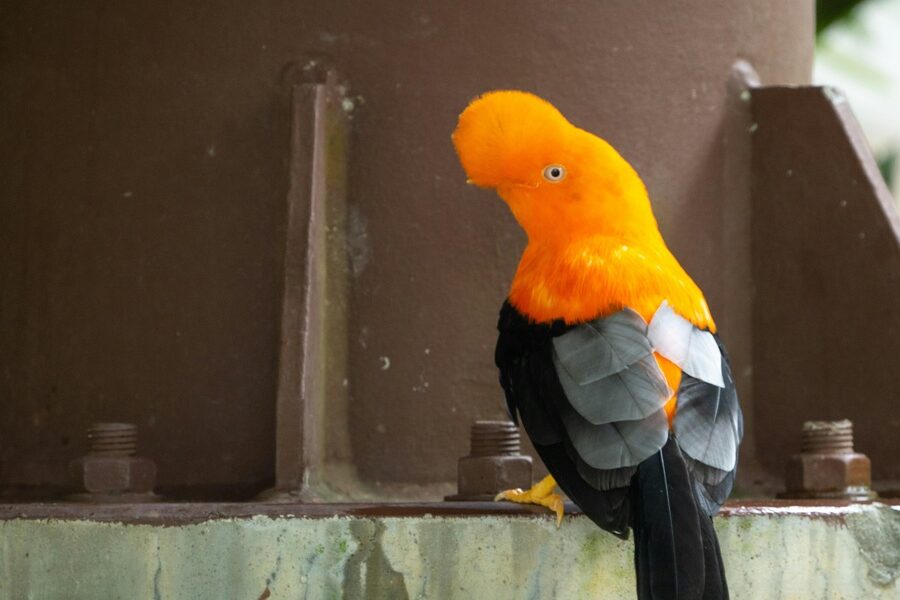South Sudan’s landscapes—from the vast Sudd wetlands to open savanna and riverine forests—support a wide array of wildlife across seasons and habitats.
There are 59 Animals of South Sudan, ranging from African buffalo to Yellow-billed stork. For each species the Scientific name,Category,Where found are listed; you’ll find below.
Animals of South Sudan
| Name | Scientific name | Category | Where found |
|---|---|---|---|
| African elephant | Loxodonta africana | mammal | Boma NP; Bandingilo NP; White Nile floodplains |
| African buffalo | Syncerus caffer | mammal | Boma NP; Bandingilo NP; savanna woodlands |
| Lion | Panthera leo | mammal | Boma NP; Bandingilo NP; savannas near the White Nile |
| Leopard | Panthera pardus | mammal | Boma NP; Bandingilo NP; riparian woodlands |
| Cheetah | Acinonyx jubatus | mammal | Boma NP; Bandingilo NP; open floodplain grasslands |
| Spotted hyena | Crocuta crocuta | mammal | Boma NP; Bandingilo NP; savannas and woodlands |
| Striped hyena | Hyaena hyaena | mammal | scattered dry bushlands; outskirts of protected areas |
| Hippopotamus | Hippopotamus amphibius | mammal | White Nile; Sudd wetlands; larger rivers |
| Nile lechwe | Kobus megaceros | mammal | Sudd wetlands; swampy grasslands; Boma NP edge |
| White-eared kob | Kobus kob | mammal | Bandingilo NP; Boma NP; migration routes across plains |
| Topi | Damaliscus lunatus | mammal | Boma NP; Bandingilo NP; floodplain grasslands |
| Roan antelope | Hippotragus equinus | mammal | wooded savannas; park fringes such as Boma and Bandingilo |
| Eland | Taurotragus oryx | mammal | open savanna and woodlands near Nimule NP and southern parks |
| Sitatunga | Tragelaphus spekii | mammal | Sudd marshes; papyrus swamps; reedbeds |
| Waterbuck | Kobus ellipsiprymnus | mammal | riverine areas; White Nile; Sudd margins |
| Bohor reedbuck | Redunca redunca | mammal | Sudd marsh edges; floodplain grasslands |
| Warthog | Phacochoerus africanus | mammal | savannas and floodplain grasslands; Boma and Bandingilo |
| Impala | Aepyceros melampus | mammal | savannas and woodlands such as Boma NP |
| Bushbuck | Tragelaphus scriptus | mammal | woodlands, gallery forest along rivers; Nimule NP |
| Giraffe | Giraffa camelopardalis | mammal | Boma NP; Bandingilo NP; scattered woodlands |
| Olive baboon | Papio anubis | mammal | savanna woodlands; near villages and park edges |
| Vervet monkey | Chlorocebus pygerythrus | mammal | gallery forests; river edges; Nimule region |
| Patas monkey | Erythrocebus patas | mammal | open savannas; dry grasslands around Boma |
| Serval | Leptailurus serval | mammal | wet grasslands and reedbeds near Sudd; floodplains |
| Honey badger | Mellivora capensis | mammal | savanna and scrub habitats; park outskirts |
| Shoebill | Balaeniceps rex | bird | Sudd wetlands; papyrus channels; marshes |
| Secretarybird | Sagittarius serpentarius | bird | open grasslands and savanna plains; Bandingilo and Boma |
| African fish eagle | Haliaeetus vocifer | bird | White Nile; large rivers and lakes; Sudd edges |
| Saddle-billed stork | Ephippiorhynchus senegalensis | bird | Sudd wetlands; riverine floodplains |
| Marabou stork | Leptoptilos crumenifer | bird | open wetlands; riverbanks; agricultural areas |
| Wattled crane | Bugeranus carunculatus | bird | extensive marshes of the Sudd; shallow flooded grasslands |
| Papyrus gonolek | Laniarius mufumbiri | bird | papyrus swamps in the Sudd |
| African jacana | Actophilornis africanus | bird | Sudd wetlands; floating vegetation on lakes and rivers |
| Goliath heron | Ardea goliath | bird | large rivers, floodplains and marshes; White Nile |
| Great white pelican | Pelecanus onocrotalus | bird | flooded lakes and the Sudd; seasonal concentrations on large water bodies |
| Yellow-billed stork | Mycteria ibis | bird | shallow wetlands and flooded grasslands; Sudd margins |
| Kori bustard | Ardeotis kori | bird | open dry grasslands and plains such as Boma |
| Lilac-breasted roller | Coracias caudatus | bird | savanna woodlands and open country; park edges |
| African skimmer | Rynchops flavirostris | bird | large rivers and sandbars on the White Nile; seasonal colonies |
| Pied kingfisher | Ceryle rudis | bird | river channels, reservoirs and lakes; White Nile |
| Northern carmine bee-eater | Merops nubicus | bird | riverine cliffs and sandbanks along the White Nile and tributaries |
| African darter | Anhinga rufa | bird | rivers, lakes and papyrus channels; Sudd |
| African openbill | Anastomus lamelligerus | bird | marshes and flooded grasslands; Sudd wetlands |
| Nile crocodile | Crocodylus niloticus | reptile | White Nile; rivers, lakes and Sudd channels |
| African rock python | Python sebae | reptile | wooded areas and riverbanks; riparian habitats |
| Nile monitor | Varanus niloticus | reptile | rivers, marshes and floodplains; Sudd |
| Egyptian cobra | Naja haje | reptile | savannas, agricultural edges and riverine scrub |
| Puff adder | Bitis arietans | reptile | savannas and grasslands; park edges and bush |
| African helmeted turtle | Pelomedusa subrufa | reptile | shallow pools, lagoons and marshes in the Sudd |
| African softshell turtle | Trionyx triunguis | reptile | rivers and large water bodies such as the White Nile |
| Black mamba | Dendroaspis polylepis | reptile | rocky outcrops, savannas and woodland edges |
| African bullfrog | Pyxicephalus adspersus | amphibian | seasonal pools, floodplains and savanna puddles |
| Common toad | Sclerophrys regularis | amphibian | widespread in gardens, savannas and near water |
| African clawed frog | Xenopus laevis | amphibian | permanent pools, slow rivers and marshes within the Sudd |
| Painted reed frog | Hyperolius marmoratus | amphibian | reedbeds, papyrus and shallow marshes |
| Mascarene grass frog | Ptychadena mascareniensis | amphibian | floodplains, ditches and seasonal pools across savannas |
| Bocage’s tree frog | Leptopelis bocagii | amphibian | gallery forest edges and damp woodlands |
| African rock agama | Agama agama | reptile | savanna woodlands, rock outcrops and park roadsides |
| Sooty mangabey? (exclude uncertain primates) | — | — | — |
Images and Descriptions

African elephant
Massive gray herbivore with tusks and large ears; moves in family herds across savannas and floodplains. Iconic foragers you can spot at waterholes and riverbanks, especially during the dry season.

African buffalo
Large, heavyset bovine usually seen in big herds. Known for unpredictable temperament and strong social bonds; commonly found grazing near rivers and grasslands, often with herds of thousands in wetter years.
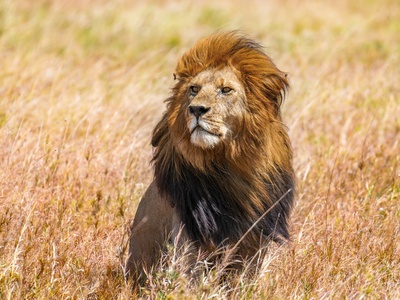
Lion
Powerful social predator living in prides. Look for lions at dawn and dusk near large prey concentrations; sightings are possible in core park areas where prey like kob and buffalo congregate.
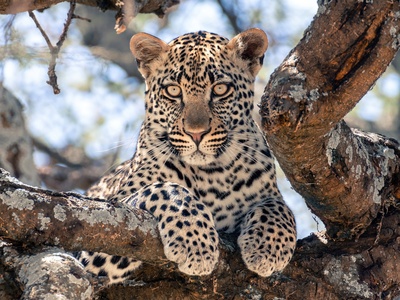
Leopard
Elusive, solitary big cat with spotted coat that hunts by stealth. Often nocturnal and hard to spot, leopards frequent riverine trees and rocky outcrops; occasional daytime sightings in quieter park sectors.
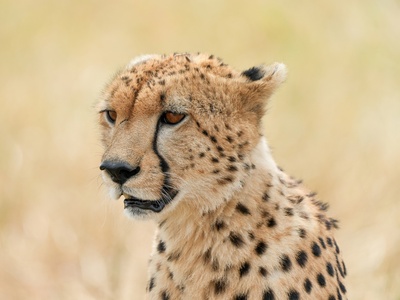
Cheetah
Slim, long-legged sprinter with distinctive tear stripes. Extremely fast on short sprints, cheetahs are rare but can be seen where open plains support herds of kob and topi.
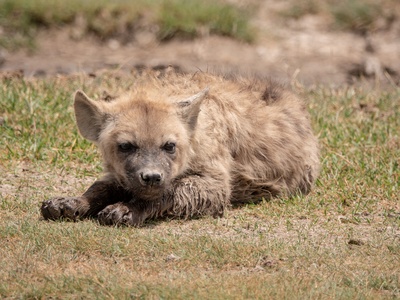
Spotted hyena
Robust social carnivore known for loud whoops and strong jaws. Scavenges and hunts in clans; easy to hear at night and often seen near carcasses or waterpoints.

Striped hyena
Smaller, nocturnal hyena with striped flanks and solitary habits. Scavenger of dry areas; uncommon but present across drier parts of South Sudan.

Hippopotamus
Enormous semi-aquatic herbivore spending days submerged to keep cool. Best seen at dusk when they graze on riverbanks; dangerous if approached, but a highlight of boat trips in the Sudd.
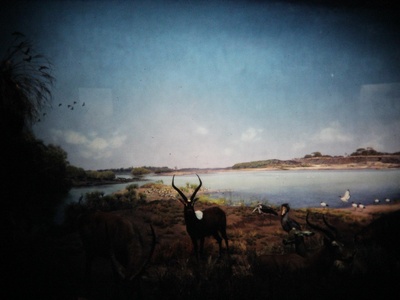
Nile lechwe
Swamp-specialist antelope with long legs and reddish coat adapted for flooded grasslands. Forms local aggregations and is a conservation symbol of South Sudan’s wetlands.

White-eared kob
Medium-sized antelope famed for massive seasonal migrations across grasslands. Pale patch behind the ear and a white belly make it distinctive; prime sighting during migration seasons.
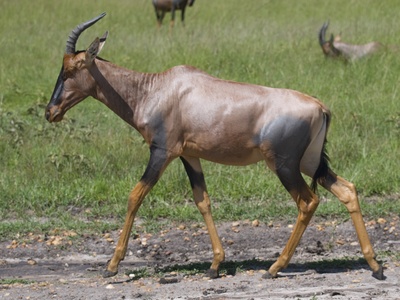
Topi
Fast, reddish antelope often found in herds on open plains. Makes short bursts of speed and perches on termite mounds to survey for predators; common where grasses are fresh and green.
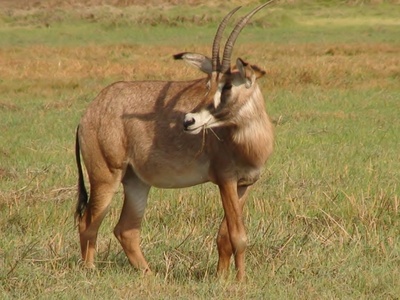
Roan antelope
Large, horse-like antelope with backward-swept horns and a brindled face. A shy browser of taller grasses and woodlands; notable for its striking profile and size.

Eland
The largest African antelope with a heavy body and spiral horns. Slow-moving browser often in small groups; look for its characteristic dewlap and hump on the shoulders.

Sitatunga
Secretive, swamp-adapted antelope with elongated hooves for walking on floating vegetation. Best seen from boats or hides in papyrus channels; well camouflaged among reeds.

Waterbuck
Large grey-brown antelope that stays near water. Distinctive white rump ring and musky odor; common along rivers and in floodplain grasslands.
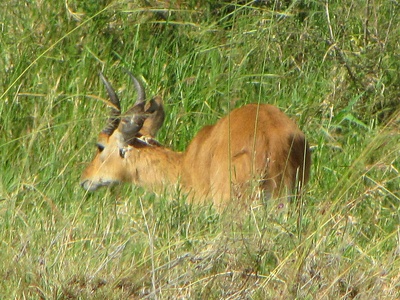
Bohor reedbuck
Medium-sized reedbuck that grazes on floodplain grasses. Shy and alert, often spotted in early morning or late afternoon near tall grass and marsh edges.
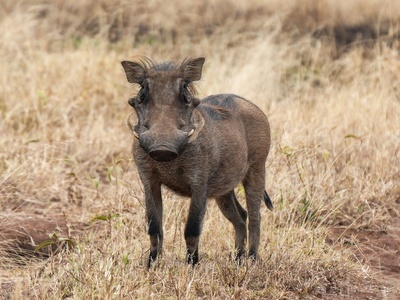
Warthog
Stocky wild pig with characteristic facial warts and tusks. Often seen grazing or kneeling to feed; common and unmistakable on open plains.
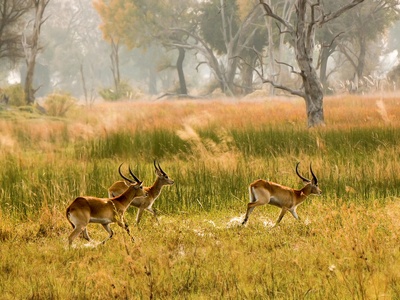
Impala
Graceful medium antelope with lyre-shaped horns on males. Agile jumper often seen in mixed herds; a common prey species for large predators.

Bushbuck
Solitary, shy forest antelope with mottled coat. Frequently heard more than seen; good chance to spot males at dawn near dense cover.

Giraffe
Tall, long-necked browser feeding on acacia leaves. Impressive silhouette against the savanna; easiest to spot from a distance or on skyline drives.

Olive baboon
Large social primate living in troops. Omnivorous and conspicuous, often seen foraging on the ground and in trees. Bold near human settlements; interesting behavioral displays.
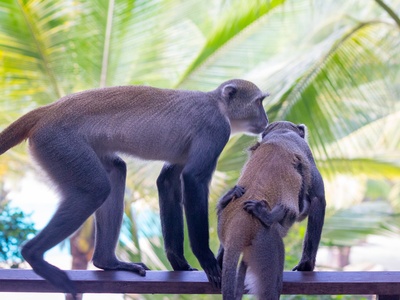
Vervet monkey
Small, gray-green monkey with black face and white eye rings. Agile and noisy in trees; commonly seen in forest patches and along rivers.
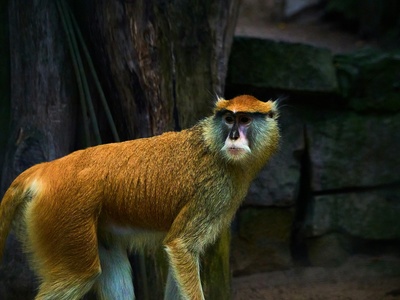
Patas monkey
Long-limbed, fast ground-dwelling monkey with reddish coat. Often found in open country and easily seen during daytime foraging.

Serval
Slender spotted cat with long legs and large ears adapted for hunting rodents in tall grass. Nocturnal and secretive but sometimes glimpsed at dawn or dusk.
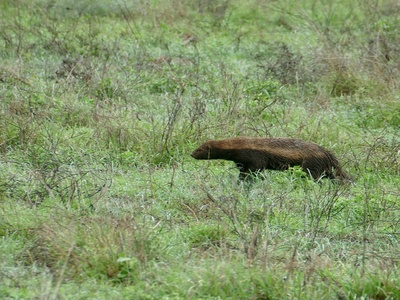
Honey badger
Bold, solitary mustelid noted for toughness and curiosity. Digs for prey and raids beehives; rarely seen but known for fearless behavior when encountered.
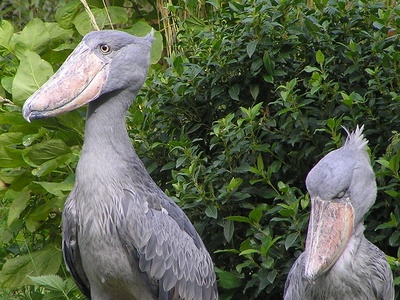
Shoebill
Iconic, prehistoric-looking bird with a massive shoe-shaped bill. Stands motionless in shallow water hunting fish; prime target for birders visiting the Sudd and swampy channels.
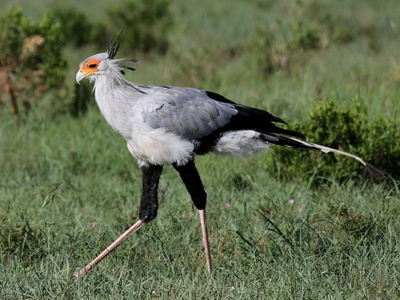
Secretarybird
Tall, terrestrial raptor with long legs that hunts snakes and insects by stomping. Distinctive crest and slow, deliberate walking make it easy to identify on the plains.

African fish eagle
Powerful raptor commonly perched by water with a white head and chest. Hunts fish with dramatic dives; its loud call is an iconic river sound.
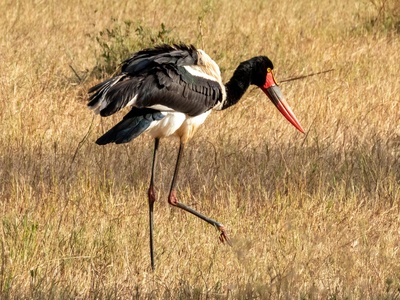
Saddle-billed stork
Large, striking stork with colorful bill and long legs. Feeds in shallow waters on fish and frogs; often seen singly or in small groups in marshes.
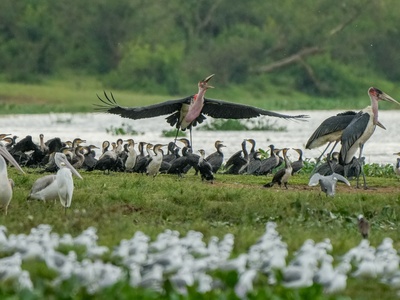
Marabou stork
Huge scavenging stork with bare head and dangling throat sack. Often spotted near villages and wetlands feeding on carrion and waste; unmistakable silhouette.
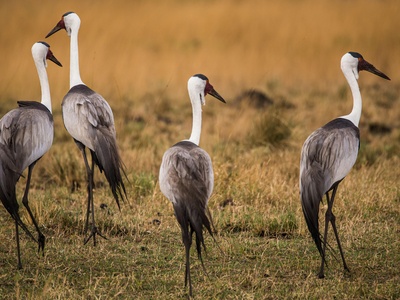
Wattled crane
Elegant, tall wetland crane with long legs and distinctive red throat wattle. Very dependent on intact wetlands and a rewarding sight for wetland birding trips.
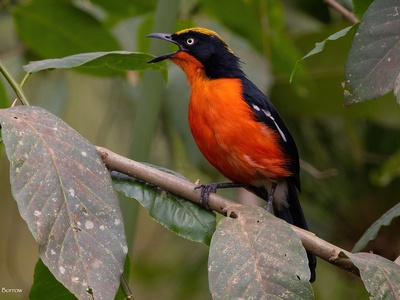
Papyrus gonolek
Colorful, secretive songbird of papyrus reedbeds with deep red and black plumage. Heard more often than seen; best located by its loud, ringing calls from dense reeds.

African jacana
Lightweight wader with long toes that walk on lily pads. Striking breeding plumage and agile movements make it a fun species to watch on boat trips.
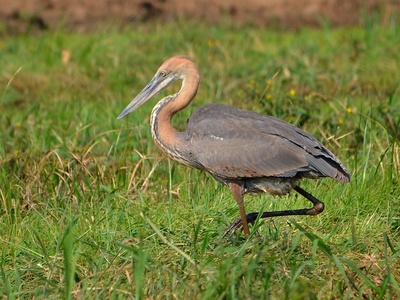
Goliath heron
World’s largest heron, dark and beefy, stalking big fish in shallow water. Slow and deliberate hunter often seen standing solitary among reeds.

Great white pelican
Huge white pelican with large throat pouch used to scoop fish. Gathers in flocks and performs spectacular group fishing when fish are abundant.

Yellow-billed stork
Elegant long-legged stork with pinkish legs and yellow bill. Forages with sweeping bill in shallow water for fish and amphibians; common in wet seasons.

Kori bustard
One of the heaviest flying birds, ground-dwelling and often seen walking slowly across plains. Males perform impressive display flights and ground displays during breeding.

Lilac-breasted roller
Vibrant, colorful bird often perched conspicuously on trees or wires. Agile aerial insect hunter; frequent and photogenic at roadside stops.

African skimmer
Slender black-and-white tern-like bird that skims the water surface with its lower bill to catch fish. Best seen on sandbars and river bends.
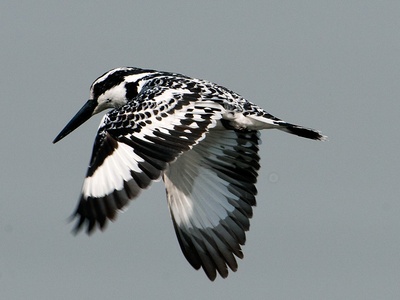
Pied kingfisher
Bold black-and-white fishing bird that hovers over water before plunging for fish. One of the easiest river species to watch from boats and riverbanks.

Northern carmine bee-eater
Brilliant red and turquoise bee-eater that nests in sandbanks and forages for flying insects. Spectacular flocks and colorful appearance delight birders along rivers.

African darter
Long-necked water bird that swims low with a snake-like neck visible. Dries wings perched on logs after fishing; common in slow-moving waterways.
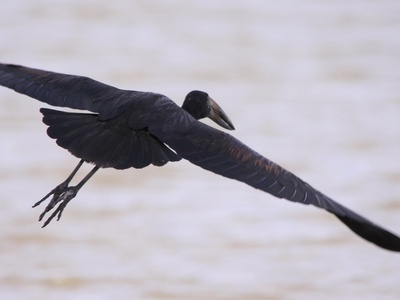
African openbill
Stork with a unique gap in its bill adapted to eating snails. Often seen feeding in shallow waters tearing open snail shells; a quirky stork species of wetlands.

Nile crocodile
Large ambush predator sunning on banks and sheltering in deep pools. A major part of river ecosystems; boat-based sightings are common but exercise caution and keep distance.

African rock python
Massive constrictor that ambushes mammals and birds. Often hides near water and in dense vegetation; rarely seen but known to inhabit thick cover along rivers.

Nile monitor
Large semi-aquatic lizard that swims and climbs with ease. Opportunistic predator and scavenger; often spotted near water basking on logs and banks.
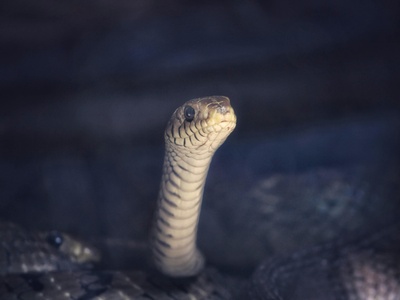
Egyptian cobra
Large venomous snake with hood display. Typically nocturnal and secretive; sighted occasionally in dry bush and near human settlements.

Puff adder
Heavy-bodied venomous viper with excellent camouflage. Often lies in wait for small mammals; dangerous if accidentally stepped on, so watch your step in tall grass.
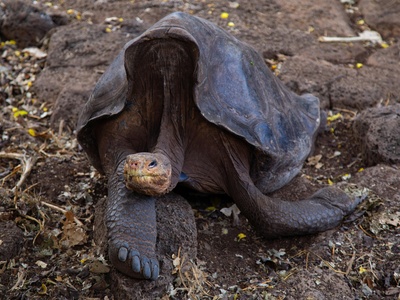
African helmeted turtle
Small freshwater turtle that surfaces often for air and basks on logs. Common in seasonal ponds and easy to spot during boat trips.
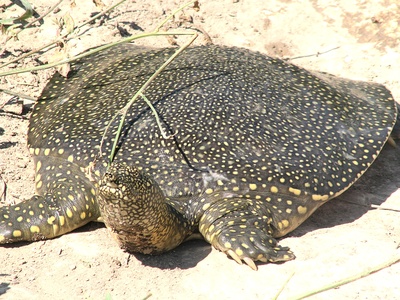
African softshell turtle
Flattened, leathery-shelled turtle that buries in mud and ambushes fish. Less visible than basking turtles but present in major waterways.

Black mamba
Highly venomous and fast snake with a reputation for agility. Prefers dryer, rocky habitats and is generally shy, though encounters are serious and require caution.

African bullfrog
Large, robust frog that estivates in dry season and emerges explosively with rains. Male breeding behavior includes guarding tadpoles in shrinking pools—surprising parental care.

Common toad
Warty, medium-sized toad common across human-modified habitats. Breeds in temporary pools after rains; often heard calling loudly at night in wet seasons.
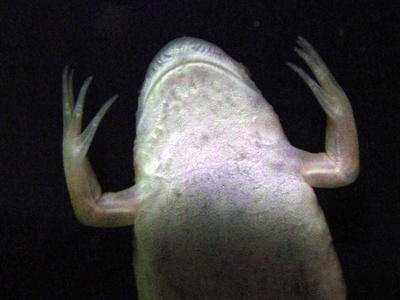
African clawed frog
Fully aquatic frog with flattened body and clawed hind toes. Often used as a model species in labs and common in quiet waters.
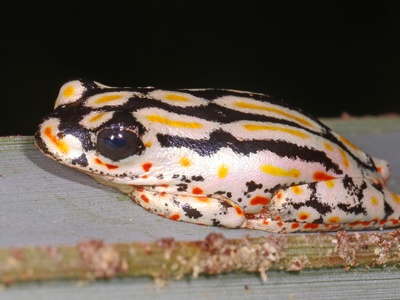
Painted reed frog
Small, colorful tree frog often perched on reeds. Nocturnal calling choruses in the rainy season make it easy to detect in wetland habitats.
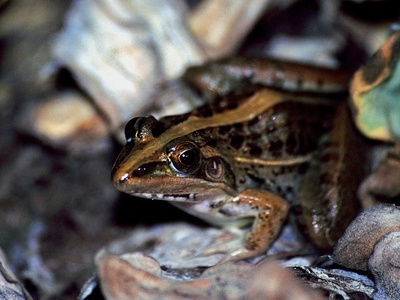
Mascarene grass frog
Slim, quick-jumping frog that breeds explosively in ephemeral pools. Very common after rains and frequently seen hopping across flat grassy areas.

Bocage’s tree frog
Arboreal tree frog with melodic calls heard at night. Often perched on vegetation near water, it blends into leafy backgrounds and is more often heard than seen.

African rock agama
Colorful lizard often basking on rocks and fence posts. Males show brilliant blues and reds during breeding; a common roadside reptile.

Sooty mangabey? (exclude uncertain primates)
—
